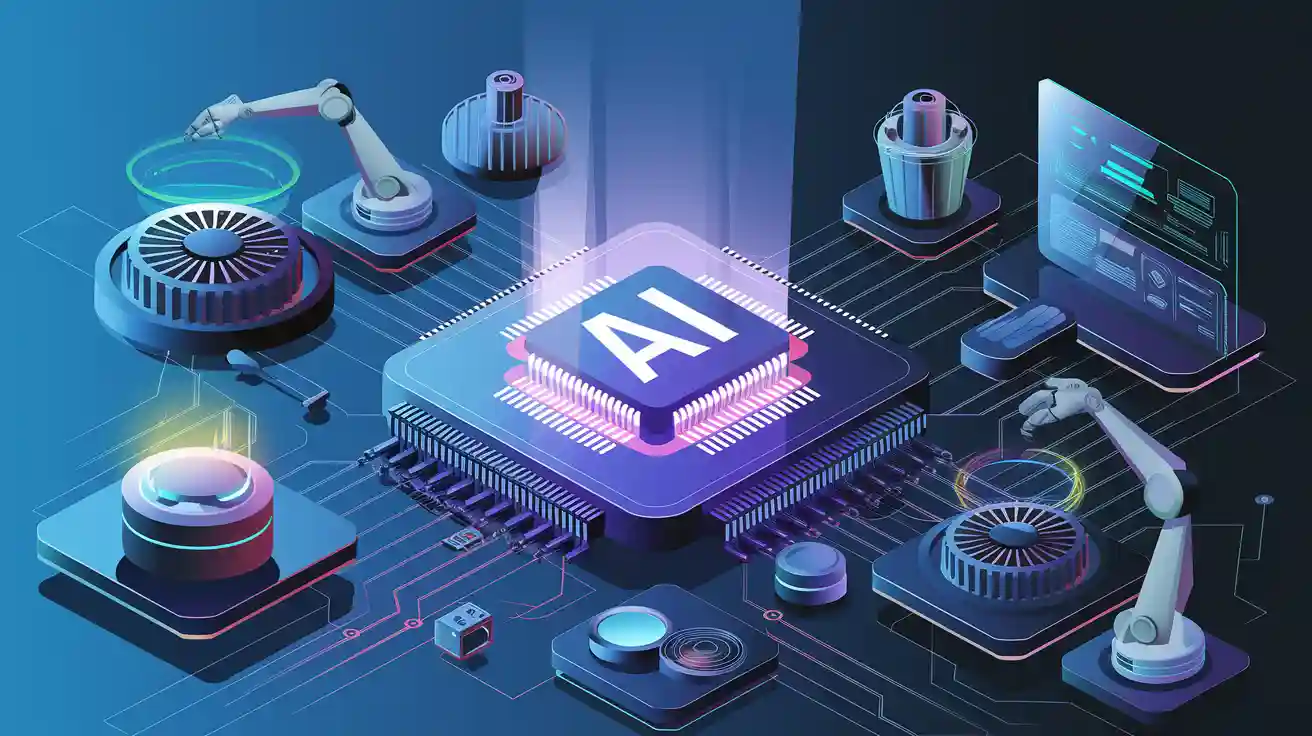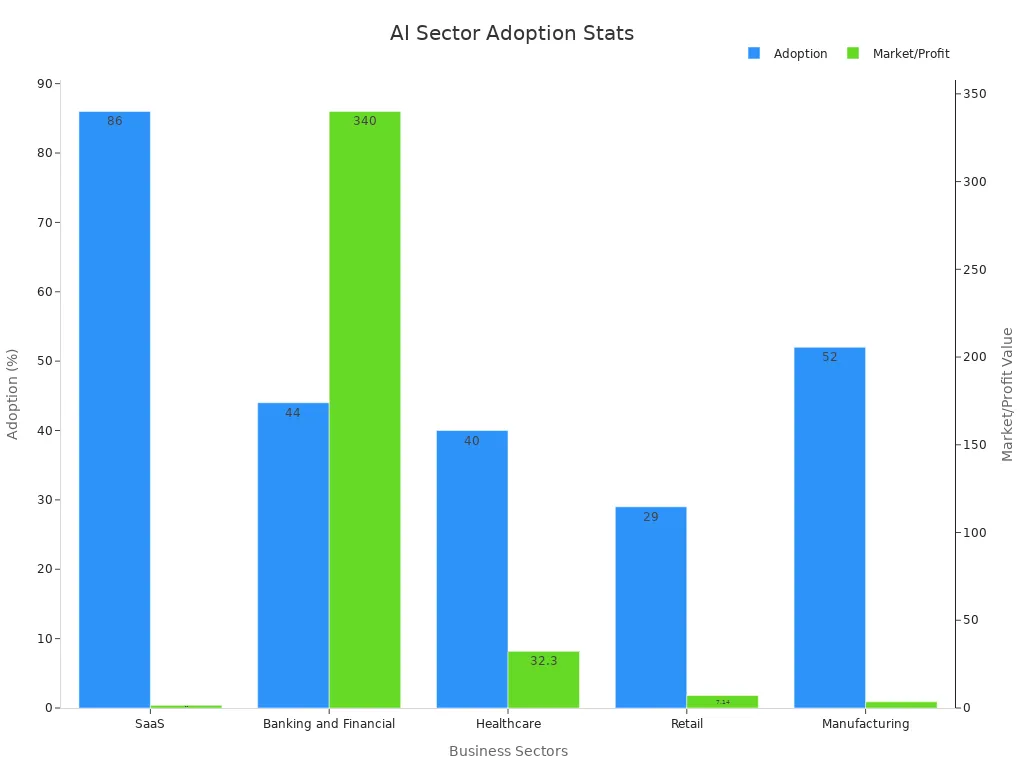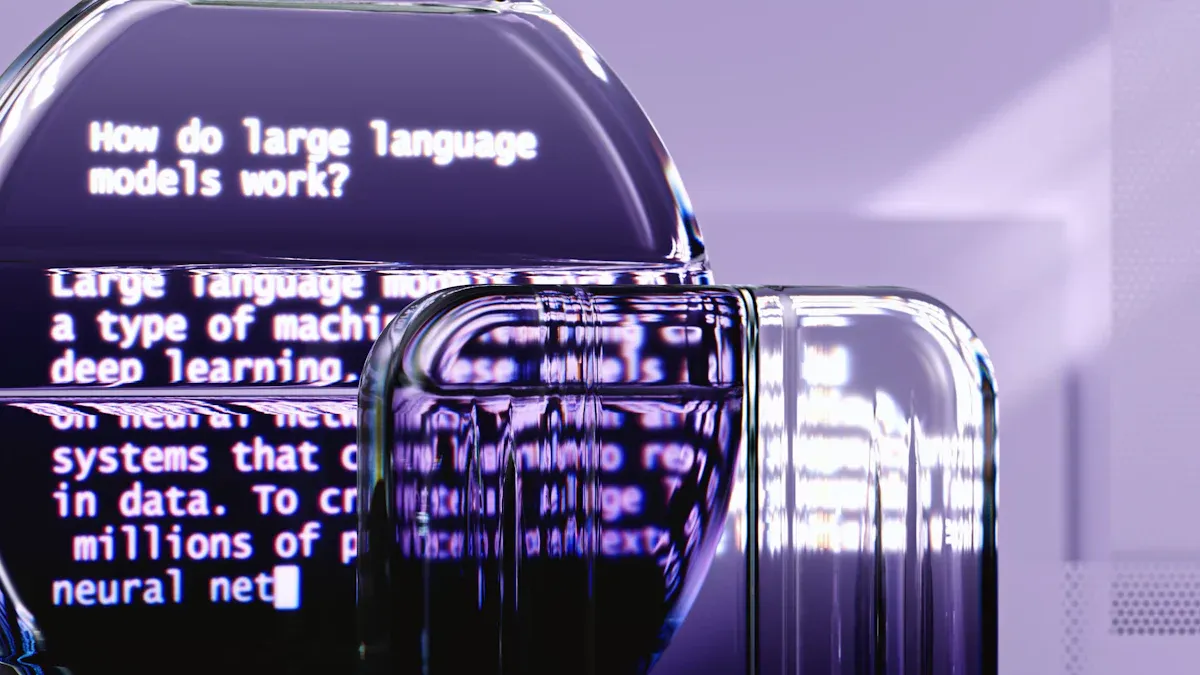
The AI+ Initiative is revolutionizing how industries operate by embedding artificial intelligence into core processes. This digital transformation enables businesses to enhance efficiency, foster innovation, and address challenges with smarter solutions. For example, 60% of manufacturers now use AI-driven automation and predictive maintenance, leading to more cost-effective production. In retail, 73% of companies rely on AI for demand forecasting and personalized marketing, boosting operational efficiency. These advancements demonstrate how AI is not only transforming industries but also reshaping the global economy, making businesses more adaptable and competitive in a rapidly evolving world.
Key Takeaways
-
AI is changing industries by making work faster and smarter. Companies can use AI to make tasks easier and solve tough problems.
-
Start small with AI. Find areas where it can help right away, like fixing machines before they break or creating ads just for certain shoppers.
-
AI tools help people make better choices by studying data. This lets businesses react quickly to changes and improve their plans.
-
Using AI in work helps the planet. It cuts waste, saves resources, and supports green practices in many fields.
-
Train workers to get ready for jobs with AI. Teaching your team new skills helps them use AI well and work better.
Transforming Industries with the AI+ Initiative

Why traditional industries are embracing AI
You may wonder why traditional industries are turning to AI. The answer lies in its ability to solve complex challenges, streamline operations, and unlock new opportunities. AI enhances decision-making, optimizes supply chains, and automates repetitive tasks. For example, AI-driven analytics are transforming how companies engage with markets, especially in sectors like healthcare and finance. In life sciences, AI has shifted from being a competitive advantage to a necessity, helping businesses stay relevant in a fast-changing world.
Consider the global impact of AI adoption. In the United States, AI in healthcare and finance has contributed an estimated 0.8% annual GDP growth from 2015 to 2023. Similarly, China’s investment in smart manufacturing has led to a 25% productivity boost in factories. These examples highlight how AI is not just a tool but a catalyst for business transformation with AI.
AI also plays a critical role in addressing industry-specific challenges. In agriculture, a farm in Brazil used AI-powered soil sensors and drones to increase crop yields by 20%. In energy, Germany’s smart grid systems reduced distribution losses by 15%, aligning with the EU’s green growth agenda. These success stories demonstrate how AI is transforming industries and driving global progress.
Tip: If you’re exploring how to adopt AI in your business, start by identifying areas where automation or data-driven insights can create the most value.
The role of AI in driving innovation and efficiency
AI is revolutionizing industries by fostering innovation and improving efficiency. It enables businesses to scale operations, streamline processes, and explore new markets. For instance, AI tools like natural language processing and predictive analytics simplify tasks such as idea generation and feasibility assessments. This approach fosters innovative business models and reshapes traditional methods.
A study from ESMT Berlin highlights how AI enhances open innovation. By improving scalability and efficiency, AI enables new forms of collaboration and accelerates digital transformation. CEOs across industries recognize the immediate benefits of AI implementation, citing its role in solving previously unsolvable challenges.
The numbers speak for themselves. AI is projected to contribute $15.7 trillion to the global economy by 2030. It is also expected to create 97 million new jobs by 2025, resulting in a net gain of 12 million roles. Moreover, 72% of organizations have already integrated AI into at least one business function, with 50% using it across multiple functions. These statistics underscore AI’s transformative potential.
In addition to driving innovation, AI significantly boosts efficiency. For example, 54% of executives report noticeable productivity improvements from AI adoption. In Germany, AI-powered energy systems have achieved efficiency gains of 20%, while in healthcare, states with high AI adoption have seen 15% higher productivity growth. These advancements illustrate how AI is reshaping industries and creating a more sustainable future.
Note: To maximize the benefits of AI, focus on integrating it into areas where it can enhance both innovation and efficiency.
Key Sectors Leading Business Transformation with AI
Manufacturing: Intelligent production and predictive maintenance
AI in manufacturing has revolutionized production processes and maintenance strategies. Intelligent production systems use AI to optimize workflows, reduce waste, and improve product quality. Predictive maintenance, powered by AI, minimizes unplanned downtime and lowers operational costs. For instance:
-
Companies like Frito-Lay and General Motors have reported significant savings by adopting predictive maintenance.
-
Studies show that AI can reduce downtime by 30-50% and cut maintenance costs by 15-30%.
These advancements make AI in manufacturing a critical driver of efficiency and innovation. The market for AI in manufacturing was valued at $3.5 billion in 2023, with 52% of manufacturers already leveraging AI tools.
Tip: To implement AI in manufacturing, start with predictive maintenance to achieve quick, measurable results.
Agriculture: Precision farming and resource optimization
AI in agriculture is transforming how you grow and manage crops. Precision farming uses AI to analyze soil conditions, predict optimal seed varieties, and monitor crop health in real time. Self-driving tractors and drones enhance efficiency in tasks like spraying and harvesting. AI also supports farmers with financial models that offer customized insurance plans, reducing risks.
Key benefits include:
-
Improved crop yields through real-time soil analysis.
-
Enhanced resource optimization with autonomous farming tools.
-
Reduced financial uncertainty with AI-driven investment strategies.
AI in agriculture is not just about technology; it’s about sustainability. By optimizing resources, you can reduce waste and improve productivity.
Healthcare: AI-powered diagnostics and patient care
AI in healthcare is reshaping how you diagnose and treat patients. AI-driven tools provide high accuracy in diagnostics, enabling earlier detection of diseases. For example, prospective cohort studies validate the safety and effectiveness of AI in medical diagnostics. However, ongoing research is essential to refine these tools and monitor their performance in clinical settings.
The global market for AI in healthcare is projected to reach $32.3 billion in 2024, with 40% of healthcare organizations already adopting AI solutions. These advancements improve patient outcomes and streamline care delivery.
|
Aspect |
Findings |
|---|---|
|
Study Type |
Prospective Cohort Study |
|
Key Results |
High accuracy and safety sensitivity of AI-driven tools in diagnostics |
|
Implications |
Validates AI's potential in medical diagnostics and emphasizes ongoing research |
AI in healthcare is not just about technology; it’s about saving lives and improving care quality.

Note: To maximize the benefits of AI in healthcare, focus on integrating it into diagnostics and patient care systems.
Retail: Personalization and enhanced customer experiences
AI is revolutionizing retail by delivering personalized experiences that cater to individual customer needs. You’ve likely noticed how online stores recommend products tailored to your preferences. This is possible because AI analyzes your browsing history, purchase patterns, and even social media activity. Retailers use this data to create targeted marketing campaigns, ensuring you see products that match your interests.
AI in retail also enhances customer service. Chatbots powered by natural language processing provide instant support, answering your questions and resolving issues 24/7. These tools improve response times and reduce the workload for human agents. For example, Sephora uses AI-driven virtual assistants to help you find the perfect beauty products, while Amazon’s recommendation engine accounts for 35% of its sales.
In physical stores, AI optimizes inventory management and improves the shopping experience. Smart shelves track stock levels in real time, ensuring popular items are always available. AI also powers cashier-less checkout systems, like Amazon Go, where you can grab items and leave without waiting in line. These innovations make shopping faster and more convenient.
Tip: To leverage AI in retail, focus on tools that enhance personalization and streamline operations.
Transportation: Smarter logistics and autonomous systems
AI is transforming transportation by making logistics smarter and introducing autonomous systems. AI in logistics optimizes routes, reduces fuel consumption, and improves delivery times. Companies like UPS use AI-driven route optimization to save millions of miles and gallons of fuel annually. This not only cuts costs but also reduces environmental impact.
Autonomous vehicles are another game-changer. Self-driving trucks equipped with AI reduce human error and operate 24/7, increasing productivity. Waymo and Aurora are already testing these solutions, paving the way for safer and more efficient freight transport. AI also enhances warehouse operations by improving inventory tracking and speeding up order fulfillment. Amazon, for instance, uses AI to streamline sorting and packing processes.
|
Area of Impact |
Description |
|---|---|
|
Autonomous Trucks |
Equipped with self-driving technology, these trucks reduce human error and enhance safety. |
|
Fleet Management |
AI tools optimize vehicle performance and routes, leading to cost savings and improved reliability. |
|
Warehouse Operations |
AI improves inventory tracking and order fulfillment, speeding up processes and reducing labor costs. |
|
Safety Improvements |
AI reduces accidents caused by fatigue and human error, maintaining safe distances and speeds. |
|
Operational Efficiency |
Autonomous trucks operate 24/7, reducing delivery times and increasing productivity. |
|
Cost Reduction |
AI helps lower operational costs through fuel efficiency and reduced reliance on manual labor. |
|
Sustainability |
AI optimizes routes to lower carbon emissions and improve inventory accuracy. |
|
Job Transformation |
Automation is likely to transform roles rather than eliminate jobs, allowing for new opportunities. |
These advancements demonstrate how AI is reshaping industries like transportation, making them more efficient and sustainable.
Note: To stay competitive, consider adopting AI tools that enhance fleet management and warehouse operations.
Technologies Powering the AI+ Initiative

Machine learning for predictive insights
Machine learning is transforming how you predict outcomes and make decisions. By analyzing historical data, machine learning algorithms identify patterns and trends that help you anticipate future events. For example, in manufacturing, machine learning predicts equipment failures, enabling proactive maintenance and reducing downtime. This approach improves efficiency and lowers costs.
You can also use machine learning to optimize supply chains. Algorithms analyze factors like demand fluctuations and transportation delays to recommend the best strategies. This ensures timely deliveries and minimizes waste. In healthcare, machine learning predicts disease outbreaks by analyzing patient data and environmental factors. These insights allow you to prepare resources and respond effectively.
Machine learning enhances scalability by automating complex processes. As your business grows, you can rely on these systems to handle larger datasets without compromising accuracy. This scalability makes machine learning a cornerstone of digital transformation across industries.
Tip: Start small by applying machine learning to one area, such as predictive maintenance, before expanding its use across your operations.
Computer vision for automation and quality control
Computer vision is revolutionizing how you automate tasks and ensure quality. This technology uses AI to interpret visual data, enabling machines to perform tasks that require human-like vision. In manufacturing, computer vision automates the identification and tracking of goods, reducing errors and improving efficiency.
Key benefits include:
-
Reduced risks of package loss or theft.
-
Faster order fulfillment through optimized picking and packing processes.
-
Lower operational costs by automating routine tasks.
The Arvist AI solution showcases the power of computer vision in quality control. At loading docks, workers capture images of pallets, which are analyzed to identify products nearing expiration. This process ensures only fresh goods reach retail locations, saving transportation costs and boosting client satisfaction.
Computer vision also supports proactive maintenance. By analyzing equipment images, AI detects wear and tear early, preventing costly breakdowns. These advancements make computer vision a vital technology for improving operational efficiency.
Natural language processing for communication and analysis
Natural language processing (NLP) enhances how you communicate and analyze information. This AI technology processes human language, making it easier to extract insights from text and speech. In healthcare, NLP simplifies medical language, improving communication between providers and patients. It also helps clinicians identify symptoms and characteristics linked to health outcomes.
NLP is effective in analyzing public sentiment. During health crises, it processes social media data to track opinions on policies, helping you understand public concerns. Businesses use NLP to analyze customer feedback, identifying trends and areas for improvement.
This technology also streamlines operations. Chatbots powered by NLP provide instant support, answering questions and resolving issues efficiently. These tools reduce the workload for human agents and improve customer satisfaction. By integrating NLP into your systems, you can enhance communication and make data-driven decisions.
Note: To maximize the benefits of NLP, focus on areas where communication and analysis are critical, such as customer service or healthcare.
IoT and AI integration for connected ecosystems
IoT and AI integration is transforming how ecosystems operate by creating smarter, more connected environments. When you combine IoT devices with AI, you unlock the ability to collect, analyze, and act on data in real time. This synergy enhances decision-making, improves efficiency, and drives innovation across industries.
IoT devices gather vast amounts of data from sensors, wearables, and connected systems. AI processes this data to uncover patterns, predict outcomes, and automate responses. For example, wearable devices track health metrics, while AI analyzes this data to help manage chronic diseases. In agriculture, IoT sensors monitor soil conditions, and AI uses this information to optimize crop production. These applications show how IoT and AI work together to solve complex challenges.
Here are some real-world examples of IoT and AI integration:
-
Chronic Disease Management: AI analyzes data from wearable devices to improve health outcomes.
-
Telemedicine: IoT devices enable remote healthcare, with AI providing accurate assessments.
-
Emergency Response: IoT collects critical health data, while AI prioritizes alerts for faster medical intervention.
-
Precision Farming: IoT sensors provide data for AI to enhance crop yields and resource management.
-
Environmental Monitoring: AI and IoT monitor air and water quality, aiding pollution control efforts.
-
Renewable Energy Integration: AI optimizes energy consumption and grid operations, reducing costs.
This integration also promotes sustainability. AI-powered IoT systems reduce waste, conserve resources, and lower energy consumption. For instance, smart grids use AI to balance energy demand and supply, minimizing environmental impact. By adopting these technologies, you can create ecosystems that are not only efficient but also eco-friendly.
IoT and AI integration is more than just a technological advancement. It’s a way to build connected ecosystems that improve lives, protect the environment, and drive progress.
Tip: To start integrating IoT and AI, focus on areas where real-time data and automation can deliver the most value, such as healthcare or energy management.
Benefits of Business Transformation with AI
Enhanced operational efficiency and cost reduction
AI transforms how you manage operations by automating repetitive tasks and optimizing workflows. This leads to significant improvements in efficiency and cost savings. For example, AI-powered systems streamline manufacturing processes, reducing waste and enhancing productivity. In agriculture, AI tools help you allocate resources more effectively, minimizing expenses while boosting yields.
You can measure these benefits through key performance indicators:
|
Metric |
Description |
|---|---|
|
Revenue growth |
Measures growth in sales and new business opportunities generated with AI’s help. |
|
Employee productivity |
Measures the increase in output per employee after AI implementation and automation of tasks. |
|
Cost savings |
Measures the reduction in expenses achieved through AI’s automation efforts. |
|
Time savings |
Indicates the reduction in time needed to complete tasks after AI implementation. |
These metrics highlight how AI drives operational efficiency and reduces costs across industries. By adopting AI, you can achieve faster results, lower expenses, and improve overall performance.
Tip: Start with small-scale AI implementations to quickly realize cost and time savings before scaling up.
Data-driven decision-making and strategic insights
AI empowers you to make smarter decisions by analyzing vast amounts of data and uncovering actionable insights. Data-driven decision-making helps you identify trends, predict outcomes, and optimize strategies. For instance, AI in retail uses customer data to forecast demand and tailor marketing campaigns, ensuring better alignment with consumer preferences.
Empirical research supports the transformative impact of data-backed decisions:
-
Executives from companies that utilize data-driven strategies are nearly three times more likely to report significant improvements in decision-making compared to those who rely less on data.
Example: A global coffee brand uses geographic information system (GIS) technology to optimize site selection for new stores. This approach improves performance and boosts sales, demonstrating how AI can enhance strategic planning.
AI also enables you to adapt quickly to changing market conditions. By leveraging predictive analytics, you can anticipate challenges and seize opportunities, ensuring your business remains competitive.
Note: To maximize the benefits of data-driven decision-making, focus on integrating AI tools that analyze customer behavior and market trends.
Improved customer satisfaction and loyalty
AI enhances customer experiences by delivering personalized interactions and efficient support. For example, AI in healthcare improves patient care by tailoring treatment plans based on individual needs. Similarly, AI in retail uses recommendation engines to suggest products that match your preferences, creating a more engaging shopping experience.
Key benefits of AI-driven customer satisfaction include:
-
Personalized interactions that cater to individual needs.
-
Efficient handling of higher support volumes without compromising quality.
-
Improved team productivity, which boosts customer loyalty.
For instance, Liberty London uses Zendesk AI to understand customer intent and sentiment. This allows agents to tailor responses effectively, ensuring a positive experience for every interaction.
AI also helps you build stronger relationships with customers by anticipating their needs and resolving issues proactively. By integrating AI into your customer service systems, you can enhance satisfaction and foster long-term loyalty.
Tip: Focus on AI solutions that improve personalization and streamline customer support to maximize satisfaction and retention.
Promoting sustainability and reducing environmental impact
AI plays a pivotal role in promoting sustainability by optimizing resource use and reducing waste. You can see its impact across industries like energy, agriculture, and transportation. For example, AI algorithms improve energy systems by balancing supply and demand, which minimizes waste and conserves resources. In agriculture, AI-powered precision farming reduces the need for chemical fertilizers and pesticides. This approach not only protects the environment but also enhances crop yields, ensuring long-term sustainability.
AI also contributes to climate change mitigation. Advanced climate modeling powered by AI helps you understand weather patterns and predict environmental changes. These insights enable better planning for renewable energy projects, making them more efficient compared to fossil fuels. For instance, AI optimizes wind and solar energy systems by predicting weather conditions and adjusting operations in real time. This ensures maximum energy output while reducing reliance on non-renewable sources.
Transportation systems benefit significantly from AI's ability to enhance efficiency. AI-powered route optimization reduces fuel consumption and emissions, making logistics more eco-friendly. Autonomous vehicles equipped with AI further lower environmental impact by operating efficiently and reducing traffic congestion. These advancements demonstrate how AI transforms transportation into a more sustainable sector.
Water conservation is another area where AI excels. Smart irrigation systems use AI to monitor soil moisture and weather conditions, ensuring water is used only when necessary. This reduces waste and supports sustainable farming practices. AI also helps detect leaks in water distribution networks, preventing unnecessary loss and conserving this vital resource.
AI's ability to analyze large datasets enables you to make informed decisions that prioritize sustainability. For example, AI tools identify areas where resources are being wasted and recommend strategies to improve efficiency. Businesses use these insights to adopt greener practices, such as reducing energy consumption and minimizing waste. By integrating AI into your operations, you can contribute to a healthier planet while achieving long-term cost savings.
Tip: To maximize the environmental benefits of AI, focus on areas like energy optimization, precision farming, and water conservation. These applications deliver measurable results and support global sustainability goals.
Challenges in Transforming Industries with AI
Addressing resistance to change and adoption barriers
Resistance to change often slows the adoption of AI in industries. Employees may feel anxious about how AI will impact their roles. To overcome this, you should engage your team early in the process. Transparent and frequent communication helps reduce uncertainty. For example, explain how AI complements their work rather than replacing it. Sharing success stories from other companies can also build trust and demonstrate the benefits of AI.
Focusing on well-defined use cases is another effective strategy. Start with specific processes where AI can deliver immediate value, such as optimizing the supply chain or automating repetitive tasks. This approach allows you to showcase quick wins, which can encourage broader adoption. Additionally, investing in easy-to-use AI platforms, like no-code or low-code tools, makes the technology accessible to non-technical staff. Comprehensive training programs further reduce intimidation and help employees understand how to adopt AI effectively.
Tip: Begin with small, manageable AI projects to build confidence and expertise before scaling up.
Ensuring ethical AI use and data privacy
Ethical concerns and data privacy issues present significant challenges in AI adoption. High-profile cases, such as China’s social credit system and Clearview AI’s facial recognition database, highlight the risks of surveillance and misuse of personal data. These examples emphasize the importance of implementing AI responsibly.
To address these concerns, you should prioritize transparency in how data is collected and used. Establish clear guidelines to ensure AI systems respect individual rights. For instance, Apple’s CSAM detection system aimed to protect children but sparked debates over privacy. This shows the need for careful planning and stakeholder involvement when deploying AI.
You can also adopt robust data protection measures. Encrypt sensitive information and limit access to authorized personnel. Regular audits of AI systems help identify potential vulnerabilities, ensuring compliance with privacy regulations. By taking these steps, you can build trust and mitigate ethical risks.
Preparing the workforce for AI-driven roles
The shift toward AI-driven roles requires significant workforce preparation. Many employees feel unprepared for this transformation. Research shows that 76% of desk workers feel an urgent need to build AI expertise, while only 12% have received relevant training. This gap highlights the importance of upskilling your team.
Start by identifying the skills your workforce needs. Focus on areas like AI in logistics, finance, and data analysis. Offer dynamic learning formats, such as hands-on workshops and online courses, to make training engaging and effective. Addressing leadership gaps is equally important. With 60% of leaders lacking AI training, equipping them with the right knowledge ensures they can guide their teams through the transition.
Note: Investing in workforce development not only prepares your team for AI but also boosts morale and productivity.
The AI+ Initiative empowers you to adapt to a world driven by rapid change. By integrating AI into your operations, you unlock smarter solutions that enhance efficiency and foster innovation. Businesses across industries are achieving sustainability goals while staying competitive in evolving markets.
This transformation highlights the importance of investing in AI technologies. Collaboration between sectors ensures you can harness AI’s full potential to drive progress and create lasting impact.
Tip: Explore partnerships and training programs to maximize the benefits of AI adoption in your business.
FAQ
1. What industries benefit the most from the AI+ Initiative?
AI transforms industries like manufacturing, healthcare, agriculture, retail, and transportation. You see improvements in efficiency, innovation, and sustainability. For example, predictive maintenance in manufacturing reduces costs, while AI-powered diagnostics in healthcare save lives.
Tip: Explore AI applications in your industry to identify areas for growth.
2. How can small businesses adopt AI solutions?
Start small by using AI tools for tasks like customer service or inventory management. Platforms offering no-code solutions make AI accessible. Gradually expand its use as you see measurable results.
Example: Use AI chatbots to improve customer support without hiring additional staff.
3. Is AI expensive to implement?
AI costs vary based on the solution and scale. Cloud-based AI tools offer affordable options for small businesses. Investing in AI often leads to long-term savings through efficiency gains.
|
Cost Factor |
Description |
|---|---|
|
Initial Investment |
Software and hardware costs |
|
Operational Savings |
Reduced labor and resource waste |
4. How does AI promote sustainability?
AI optimizes energy use, reduces waste, and improves resource management. For instance, smart grids balance energy demand, while precision farming minimizes chemical use.
Note: AI helps businesses align with global sustainability goals.
5. What skills do employees need to work with AI?
Employees need skills in data analysis, machine learning basics, and AI tools. Training programs and workshops help build expertise. Leadership training ensures managers can guide teams effectively.
Tip: Start with foundational AI courses to upskill your workforce.








